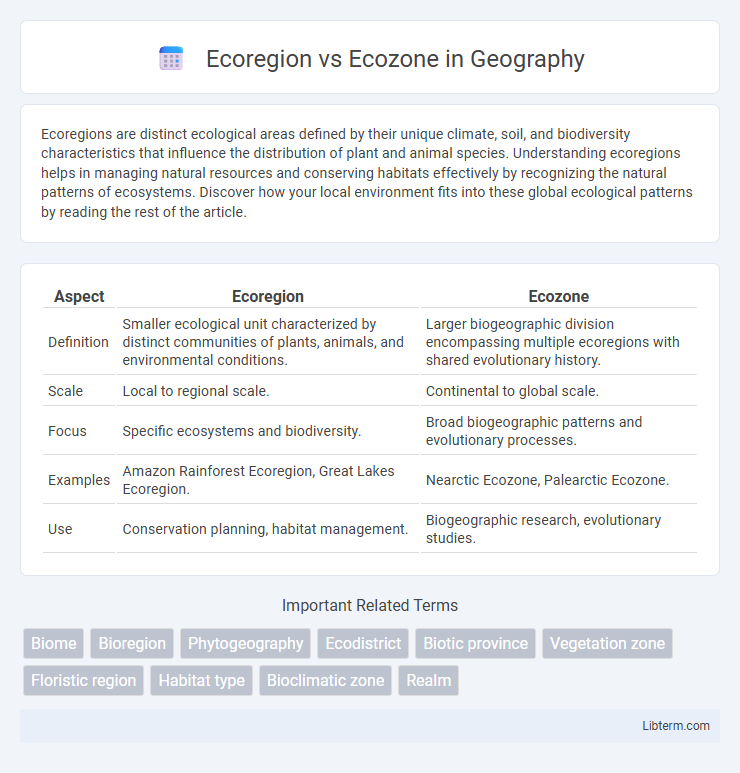Ecoregions are distinct ecological areas defined by their unique climate, soil, and biodiversity characteristics that influence the distribution of plant and animal species. Understanding ecoregions helps in managing natural resources and conserving habitats effectively by recognizing the natural patterns of ecosystems. Discover how your local environment fits into these global ecological patterns by reading the rest of the article.
Table of Comparison
| Aspect | Ecoregion | Ecozone |
|---|---|---|
| Definition | Smaller ecological unit characterized by distinct communities of plants, animals, and environmental conditions. | Larger biogeographic division encompassing multiple ecoregions with shared evolutionary history. |
| Scale | Local to regional scale. | Continental to global scale. |
| Focus | Specific ecosystems and biodiversity. | Broad biogeographic patterns and evolutionary processes. |
| Examples | Amazon Rainforest Ecoregion, Great Lakes Ecoregion. | Nearctic Ecozone, Palearctic Ecozone. |
| Use | Conservation planning, habitat management. | Biogeographic research, evolutionary studies. |
Introduction to Ecoregions and Ecozones
Ecoregions are areas defined by their unique combination of climate, soil, vegetation, and wildlife, representing distinct ecological patterns within a geographic region. Ecozones, also known as biogeographic realms, are larger global-scale units that group multiple ecoregions based on evolutionary history and major ecological similarities. Understanding the distinction between ecoregions and ecozones aids in biodiversity conservation and environmental management by providing a hierarchical framework for ecological classification.
Defining Ecoregion: Key Characteristics
An ecoregion is a geographically distinct area characterized by uniform ecological features such as climate, soil, vegetation, and species communities, supporting specific biodiversity patterns. It is smaller than an ecozone and provides a detailed framework for conservation, emphasizing local ecosystems and habitat types. Key characteristics include homogeneous environmental conditions, distinctive ecological processes, and a unique assemblage of flora and fauna adapted to these conditions.
What is an Ecozone? Core Concepts
An ecozone is a large biogeographic division of the Earth's surface defined by distinctive ecological and evolutionary patterns, encompassing multiple ecoregions with shared climate, vegetation, and fauna characteristics. It reflects broad-scale ecological phenomena and genetic heritage shaped by historical and geographical factors, often spanning continents or large ecological landscapes. Core concepts of ecozones include their role in biodiversity conservation, ecological connectivity, and the representation of global ecological diversity across terrestrial and marine environments.
Major Differences Between Ecoregions and Ecozones
Ecoregions are smaller geographic areas defined by distinct ecological features such as climate, soil, and species composition, providing detailed insights into biodiversity and habitat types. Ecozones, on the other hand, represent larger biogeographic units that encompass multiple ecoregions based on broad patterns of plant and animal distribution influenced by evolutionary history. The major difference lies in scale and specificity: ecoregions offer fine-scale ecological classifications, while ecozones provide a broad framework for understanding global biodiversity patterns.
Hierarchical Structure in Biogeographical Classification
Ecoregions represent localized ecological units characterized by distinct assemblages of flora, fauna, and environmental conditions, nested within broader ecozones that encompass multiple ecoregions sharing common biogeographic histories. Ecozones operate as higher-level classifications reflecting large-scale patterns of biodiversity shaped by continental drift and evolutionary processes, whereas ecoregions provide finer-scale resolution for conservation and management purposes. This hierarchical structure enables targeted ecological assessments by aligning regional ecosystem characteristics under the broader context of global biogeographic realms.
Global Examples of Ecozones
Ecozones represent the broadest biogeographic divisions of the Earth's surface, encompassing multiple ecoregions with similar evolutionary history and biodiversity patterns; prominent global examples include the Nearctic, Palearctic, Neotropical, Afrotropical, Indomalayan, Australasian, Oceanian, and Antarctic ecozones. Each ecozone contains diverse ecoregions characterized by distinct climate, flora, and fauna, such as the Amazon rainforest in the Neotropical ecozone or the Sahara Desert in the Afrotropical ecozone. Understanding the distinctions between ecozones and ecoregions aids in global conservation planning, as ecozones provide a macroecological context for biodiversity distribution.
Notable Ecoregions Around the World
Notable ecoregions around the world, such as the Amazon Rainforest in South America, the Congo Basin in Africa, and the Great Barrier Reef in Australia, showcase unique biodiversity and distinct ecological characteristics within their specific ecozones. While ecozones represent large biogeographic divisions defined by evolutionary history and major flora and fauna assemblages, ecoregions are smaller units that emphasize local climate, soil, and vegetation patterns. Understanding these distinctions helps conservation efforts by targeting specific habitats like the Siberian Taiga in the Palearctic ecozone or the Madagascar Dry Forests in the Afrotropical ecozone.
Importance of Scale: Ecoregion vs Ecozone
Ecoregions represent smaller, more specific areas characterized by distinct ecological patterns and environmental conditions, making them crucial for localized conservation efforts and biodiversity assessments. Ecozones encompass broader geographic regions that integrate multiple ecoregions, providing a macro-scale perspective essential for understanding global ecological processes and large-scale environmental management. The importance of scale in distinguishing ecoregions from ecozones lies in their respective applications: ecoregions enable targeted habitat protection, while ecozones facilitate comprehensive strategies addressing climate change and biogeographical patterns across continents.
How Ecoregions and Ecozones Inform Conservation
Ecoregions and ecozones offer essential frameworks for targeted conservation by categorizing landscapes based on ecological patterns and biodiversity characteristics. Ecoregions, defined by distinct assemblages of species and environmental conditions, facilitate localized conservation strategies that address specific habitat needs and threats. Ecozones encompass broader biogeographic realms, guiding large-scale conservation planning and policy development to maintain ecological integrity across continental or global scales.
Conclusion: Integrating Ecoregions and Ecozones for Biodiversity Management
Integrating ecoregions and ecozones enhances biodiversity management by combining detailed ecological characteristics with broader biogeographical patterns, facilitating more precise conservation strategies. Ecoregions offer fine-scale information on habitat types and species distribution, while ecozones provide a large-scale framework reflecting evolutionary history and climatic influences. Synergizing these perspectives supports effective ecosystem restoration, species protection, and adaptive management in response to environmental change.
Ecoregion Infographic

 libterm.com
libterm.com